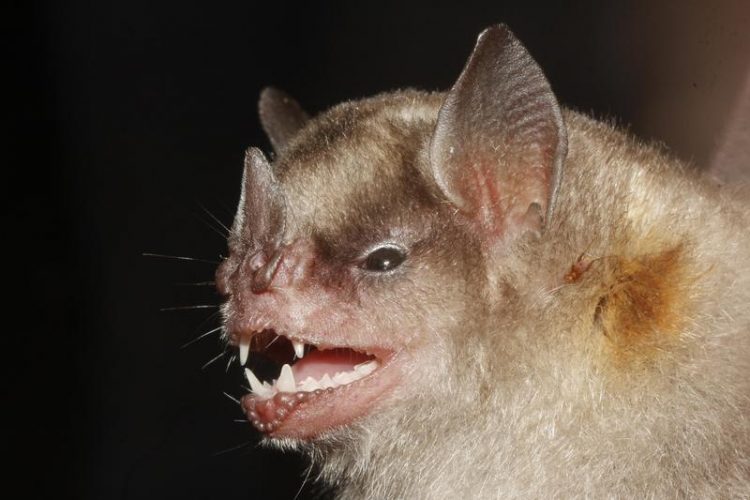First-time reconstruction of infectious bat influenza viruses

Researchers found influenza-like viruses in the bat species Sturnira lilium © Juan Cruzado Cortés
All known Influenza A viruses originate from aquatic birds that serve as virus reservoirs in nature. Avian viruses can cause severe disease and may lead to devastating pandemics when introduced into the human population.
Therefore, a world-wide surveillance program has been set up to monitor influenza virus activity in birds. It is presently unknown, however, whether additional animal reservoirs of influenza viruses exist. Surprisingly, bats were recently identified as a potential new source of influenza viruses. Genome sequences of influenza A-like viruses were identified in fruit bats in Central and South America.
Yet, all attempts to isolate infectious viruses from carrier bats have so far failed, and bat viruses could not be studied in the laboratory. Bats are mammals, as are humans, and so it is prudent to analyze such potentially harmful mammalian influenza viruses as well.
Now a team at the Institute for Virology of the Medical Center – University of Freiburg, Germany, together with scientists from Switzerland and the USA, report a break-through in isolating a bat influenza virus by reconstituting fully functional bat influenza viruses in the laboratory. Unexpectedly, the bat influenza viruses infected not only bat cells but also dog and human cells. A corresponding study was published online on October 24, 2016, in the renowned journal Proceedings of the National Academy of Sciences of the United States of America (PNAS).
Reconstructed bat influenza virus is essential for risk assessment
A first step in generating bat influenza A-like viruses was to select cell lines susceptible to infection. Such cells needed to express receptors on the cell surface for bat virus attachment and entry. The research teams analyzed over 30 cell lines from different species for their capacity to recognize and internalize bat influenza viruses. They did this by first using another virus, vesicular stomatitis virus, which can infect many different cell types. The trick was that they engineered this virus to incorporate on its own surface a bat influenza virus protein that the bat virus normally uses for entry into cells.
Then the cell line most susceptible to the engineered vesicular stomatitis virus was used to reconstruct the original bat influenza A-like virus, starting out with the known influenza-like viral genome sequences isolated from the bats. “Infectious bat viruses were readily obtained. Interestingly, most cells, including human cells, that supported infection with the vesicular stomatitis indicator virus were also susceptible to direct infection with the reconstructed bat influenza virus”, explains Prof. Martin Schwemmle, group leader at the Institute for Virology at the Medial Center – University of Freiburg.
Bats are natural hosts for several highly pathogenic viruses. In the past, Ebola and rabies virus were repeatedly transmitted from bats to humans and caused deadly diseases. The new observation that human cells can be infected with bat influenza A-like viruses is a hint that these viruses could also potentially be transmitted to humans. Although there is no evidence yet for such transmissions, the new findings are a wake-up call for more research. “It is too early to jump to definite conclusions on the ability of these virus to cross the species barrier and infect humans but our studies make it possible now to conduct further experiments and analyze the risk that these viruses pose for other species”, says Prof. Schwemmle.
Title of the publication: Synthetically derived bat influenza A-like viruses reveal a cell type- but not species-specific tropism
DOI: 10.1073/pnas.1608821113
Contact:
Prof. Dr. Martin Schwemmle
Research group leader
Institute for Virology
Medical Center – University of Freiburg
Phone: +49 761 203-6526
martin.schwemmle@uniklinik-freiburg.de
http://www.pnas.org/content/early/2016/10/20/1608821113.abstract link to the study publication
Media Contact
All latest news from the category: Life Sciences and Chemistry
Articles and reports from the Life Sciences and chemistry area deal with applied and basic research into modern biology, chemistry and human medicine.
Valuable information can be found on a range of life sciences fields including bacteriology, biochemistry, bionics, bioinformatics, biophysics, biotechnology, genetics, geobotany, human biology, marine biology, microbiology, molecular biology, cellular biology, zoology, bioinorganic chemistry, microchemistry and environmental chemistry.
Newest articles

Machine learning algorithm reveals long-theorized glass phase in crystal
Scientists have found evidence of an elusive, glassy phase of matter that emerges when a crystal’s perfect internal pattern is disrupted. X-ray technology and machine learning converge to shed light…

Mapping plant functional diversity from space
HKU ecologists revolutionize ecosystem monitoring with novel field-satellite integration. An international team of researchers, led by Professor Jin WU from the School of Biological Sciences at The University of Hong…

Inverters with constant full load capability
…enable an increase in the performance of electric drives. Overheating components significantly limit the performance of drivetrains in electric vehicles. Inverters in particular are subject to a high thermal load,…





















